Picture |
Satellite
#NORAD |
Description |
Launch Date |
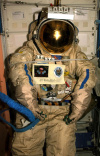
|
AMSAT
OSCAR 54
SuitSat-1
Dadioskaf
RS0RS
#28933
(2005-035C) |
SuitSat-1 was a surplus
Russian "Orlan" spacesuit re-configured to
function as a free-floating Amateur Radio transmit-only
satellite. It was released from ISS on Feb. 3rd
2006 and transmitted its voice messages "This is
SuitSat-1 RS0RS" in several languages plus telemetry
and SSTV images on an eight-minute cycle. Unfortunately
the signal strength received on 145.990 MHz was very
low. Suitsat-1 decayed on September 7th
2006. |
Feb
3rd 2006 |
 This audio
files was recorded by DF7IT operating the club station
DL0WH on February 4th 2006. This audio
files was recorded by DF7IT operating the club station
DL0WH on February 4th 2006.
|
 The same
day February 4th 2006 also
Keith ZS6TW was able to record Suitsat-1. The same
day February 4th 2006 also
Keith ZS6TW was able to record Suitsat-1.
|
VE6BLD was especially
successful receiving and recording various passes of
Suitsat-1. Kindly provided by Bob VE6BLD.
 First
telemetry data received on February 5th
at 05:35 UTC First
telemetry data received on February 5th
at 05:35 UTC
 English
voice message received on February 6th
at 5:56UTC English
voice message received on February 6th
at 5:56UTC
 Russian
voice message received on February 7th
at 6:18UTC Russian
voice message received on February 7th
at 6:18UTC
 Same Russian
voice message from unknown date and time Same Russian
voice message from unknown date and time |
Also KC5TRB was able
to receive and record Suitsat-1 during multiple passes
on several days. The 3 audio files enclosed were recorded
by KC5TRB and kindly provided by Serg RV3DR.
 Recorded
on February 10th 2006 at 14:30
UTC Recorded
on February 10th 2006 at 14:30
UTC
 Recorded
on February 11th 2006 at 07:00
UTC Recorded
on February 11th 2006 at 07:00
UTC
 Recorded
on February 12th 2006 at 13:45
UTC. Recorded
on February 12th 2006 at 13:45
UTC. |
   Some more
recordings of Suitsat-1 / RS0RS were kindly provided
by Serg RV3DR. Some more
recordings of Suitsat-1 / RS0RS were kindly provided
by Serg RV3DR.
|

|
Cubesat
OSCAR 56
Cute-1.7+APD
#28941
(2006-005C) |
This satellite built
by Tokyo Institute of Technology includes a CW beacon
(downlink 437.385 MHz) as well as a L/U packet radio
digipeater (uplink 1268.500 MHz, downlink 437.505 MHz).
It features a still camera and will send pictures of
the Earth back to ground. Its callsign is JQ1YCW. |
Feb
21st 2006 |
 CW downlink
recorded by DK3WN on Feb. 18th
2006 at 06:38 UTC. Recording kindly provided by Mike
DK3WN. CW downlink
recorded by DK3WN on Feb. 18th
2006 at 06:38 UTC. Recording kindly provided by Mike
DK3WN.
|
 CW downlink
received by EA7ADI on May 31st
2015 at 08:56 UTC using an IC-7000 with a homemade 2x7
El crossyagi. Recording kindly provided by Francisco
EA7ADI. CW downlink
received by EA7ADI on May 31st
2015 at 08:56 UTC using an IC-7000 with a homemade 2x7
El crossyagi. Recording kindly provided by Francisco
EA7ADI.
|
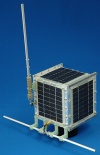 |
Hitsat
OSCAR 59
#29484
(2006-041F) |
 HITSAT
has the callsign JR8YJT and was built by Harbin Institute
of Technology (HIT). It is a Cubesat with 12cm length
and a weight of 2.2kg. It features a 1200bd AFSK PR
uplink at 145.980 MHz and a 1200bd AFSK PR downlink
at 437.425 MHz as well as a CW beacon at 437.275 MHz.
CW downlink recorded by DK3WN on Sep. 24th
2006 at 06:30 UTC. HITSAT
has the callsign JR8YJT and was built by Harbin Institute
of Technology (HIT). It is a Cubesat with 12cm length
and a weight of 2.2kg. It features a 1200bd AFSK PR
uplink at 145.980 MHz and a 1200bd AFSK PR downlink
at 437.425 MHz as well as a CW beacon at 437.275 MHz.
CW downlink recorded by DK3WN on Sep. 24th
2006 at 06:30 UTC.
|
Sep 22nd
2006 |

|
Nav
OSCAR 60
RAFT-I
#29661
(2006-055C) |
 RAFT
was launched together with ANDE MAA and ANDE FCAL on
December 21st 2006 from the
space shuttle Discovery. It is powered from batteries
only and thus has a limited lifetime. Signal reports
indicate a rather weak signal. The downlink frequency
is 145.825 MHz with either 1200Bd AFSK PR signals or
a digitized voice output. uplink is 145.825 MHz 1200Bd
AFSK PR or 28.117-28.120 MHz PSK31. PR downlink recorded
by DK3WN on Dec. 21st 2006
at 19:10 UTC. RAFT
was launched together with ANDE MAA and ANDE FCAL on
December 21st 2006 from the
space shuttle Discovery. It is powered from batteries
only and thus has a limited lifetime. Signal reports
indicate a rather weak signal. The downlink frequency
is 145.825 MHz with either 1200Bd AFSK PR signals or
a digitized voice output. uplink is 145.825 MHz 1200Bd
AFSK PR or 28.117-28.120 MHz PSK31. PR downlink recorded
by DK3WN on Dec. 21st 2006
at 19:10 UTC.
|
Dec
21st 2006 |
 RAFT
was transmitting both, PR and synthesized voice, on
Feb 13th 2007 at 21:22UTC.
Recorded by DD1US. RAFT
was transmitting both, PR and synthesized voice, on
Feb 13th 2007 at 21:22UTC.
Recorded by DD1US.
|
 QSO via
RAFT by PE1ITR and CT1ETE on Feb 12th
2007. Synthesized voice output recorded on 145.825 MHz
in FM by Paulo CT1ETE. QSO via
RAFT by PE1ITR and CT1ETE on Feb 12th
2007. Synthesized voice output recorded on 145.825 MHz
in FM by Paulo CT1ETE.
|

|
Nav
OSCAR 61
ANDE MAA
#29664
(2006-055F) |
ANDE MAA was launched
together with ANDE FCal and RAFT on December 21st
2006 from the space shuttle Discovery. ANDE MAA and
ANDE FCAL are both spherical shaped. They are powered
from batteries only and thus have a limited lifetime.
Nav OSCAR 61 features an APRS experiment with the up-
and downlink frequency 145.825 MHz (1200Bd AFSK PR).
ANDE MAA burnt up in the atmosphere on December 25th
2007. |
Dec
21st 2006 |
  Here
you can find an audio-file as well as a log-file of
the transmissions of NO-61 on January 7th
2007 which I relayed to the internet. Recorded on January
7th 2007 by DD1US. Here
you can find an audio-file as well as a log-file of
the transmissions of NO-61 on January 7th
2007 which I relayed to the internet. Recorded on January
7th 2007 by DD1US.
|
 ANDE-MAA
also had a text-to-speech converter. Uplink signals
in packet radio were converted to text and read by a
synthesized voice. Enclosed audio file was recorded
on October 13th 2007 at 15:50
UTC by Philip G0ISW. Henk PA3GUO had switched on the
Voice Mode and then Mike DK3WN sent messages to PA3GUO,
G0ISW, SP5MG and DD6UBW. Recording kindly provided by
G0ISW. ANDE-MAA
also had a text-to-speech converter. Uplink signals
in packet radio were converted to text and read by a
synthesized voice. Enclosed audio file was recorded
on October 13th 2007 at 15:50
UTC by Philip G0ISW. Henk PA3GUO had switched on the
Voice Mode and then Mike DK3WN sent messages to PA3GUO,
G0ISW, SP5MG and DD6UBW. Recording kindly provided by
G0ISW.
|
 The text-to-speech
converter was also active at Christmas 2007. Recorded
on December 19th 2007 at 10:38
UTC and kindly provided by Mike DK3WN. The text-to-speech
converter was also active at Christmas 2007. Recorded
on December 19th 2007 at 10:38
UTC and kindly provided by Mike DK3WN.
|
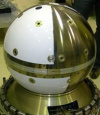
|
NRL
OSCAR 62
ANDE FCal
#29667
(2006-055J) |
ANDE FCal was launched
together with ANDE MAA and RAFT. FCAL has a diameter
of 43.9cm and is thus a bit smaller than MAA with a
diameter of 48cm. However FCal is approx. 20% heavier
than MAA and therefore the lifetime of NO-62 was longer
than NO-61. NRL OSCAR 62 featured an APRS experiment
with a 1200Bd AFSK AX.25 downlink on 437.385 MHz. ANDE
FCal burnt up in the atmosphere on May 25th
2008. |
Dec
21st 2006 |
 The downlink
signal of ANDE FCal was recorded shortly after launch
on December 21st 2006 at 20:40
UTC on 437.385 MHz in FM by Mike DK3WN. The downlink
signal of ANDE FCal was recorded shortly after launch
on December 21st 2006 at 20:40
UTC on 437.385 MHz in FM by Mike DK3WN.
|

|
Pehuensat
OSCAR 63
Pehuensat-1
#29712
(2007-001D) |
 Pehuensat-1
features an APRS experiment with the downlink frequency
145.825 MHz (1200Bd AFSK PR) as well as a voice output
in 3 languages on the same frequency. Recorded on January
26th 2007 at 08:40 UTC on 145.825
MHz in FM by Ian Ashley ZL1AOX. Pehuensat-1
features an APRS experiment with the downlink frequency
145.825 MHz (1200Bd AFSK PR) as well as a voice output
in 3 languages on the same frequency. Recorded on January
26th 2007 at 08:40 UTC on 145.825
MHz in FM by Ian Ashley ZL1AOX.
|
Jan 10th
2007 |

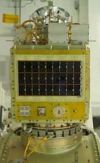
|
Falconsat-3
#30776
(2007-006E) |
FalconSat-3 is a 57kg
satellite developed by U.S. Air Force Academy in Colorado,
United States. It was launched on an Atlas-5(401) rocket
from Cape Canaveral into a circular orbit with a height
of 560km and an inclination of 35 degrees. The three
primary experiments are
- Flat Plasma Spectrometer
(FLAPS), a planar electrostatic analyzer used to measure
ion spectra differential in energy
- Plasma Local
Anomalous Noise Environment (PLANE) experiment, a bifurcated
retarding potential analyzer capable of distinguishing
between ambient and spacecraft-induced turbulence
- Micro-Propulsion Attitude Control System (MPACS),
consisting of a set of Teflon-fueled pulsed plasma thrusters
used to stabilize satellite attitude.
Falconsat-3
is switched on during most day and evening passes over
the USAFA with a very strong downlink on UHF. It is
running the pacsat file system so anyone with WiSP can
copy telemetry.
After concluding its primary missions
Falconsat-3 was transferred to full amateur radio service
in late summer 2017. It operates as a store-and-forward
system. The 9k6 bps uplink is at 145.840 MHz, the 9k6
bps downlink is at 435.103 MHz, It may support also
38k4 or 76k8 bps in the future. |
Mar
9th 2007 |
 Mineo
Wakita, JE9PEL, received the 9600bd GMSK downlink signal
on 435.103 MHz of FalconSat-3 on October 10th
2017 from 20:46-20:57 UTC. Recording kindly provided
by Wakita san JE9PEL. Mineo
Wakita, JE9PEL, received the 9600bd GMSK downlink signal
on 435.103 MHz of FalconSat-3 on October 10th
2017 from 20:46-20:57 UTC. Recording kindly provided
by Wakita san JE9PEL.
|
  On December
18th 2022 at 07:25UTC, shortly
before Falconsat-3 burnt up in the atmosphere, I received
the downlink signal on 435.103 MHz using my Satnogs
station. Enclosed you can find a screenshot of the waterfall
and the audio recording. On December
18th 2022 at 07:25UTC, shortly
before Falconsat-3 burnt up in the atmosphere, I received
the downlink signal on 435.103 MHz using my Satnogs
station. Enclosed you can find a screenshot of the waterfall
and the audio recording.
|
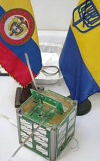
|
Libertad-1
#31128
(2007-012M) |
 Libertad-1
(callsign 5K3L) was the first Columbian satellite and
was built at the University Sergio Arboleda. This little
Cubesat with a weight of only 1 kg featured no solar
cells and thus its lifetime was limited to about 2 months.
It had a packet radio (AX25) transponder with a 2m uplink
at 145.825 MHz (1200bd AFSK) and a 70cm downlink at
437.405 MHz (1200bd AFSK). To save power the downlink
beacon transmitted a short burst every 10 minutes. Such
PR frames were received on April 17th
2007 at 21:19UTC by Mike DK3WN. Libertad-1
(callsign 5K3L) was the first Columbian satellite and
was built at the University Sergio Arboleda. This little
Cubesat with a weight of only 1 kg featured no solar
cells and thus its lifetime was limited to about 2 months.
It had a packet radio (AX25) transponder with a 2m uplink
at 145.825 MHz (1200bd AFSK) and a 70cm downlink at
437.405 MHz (1200bd AFSK). To save power the downlink
beacon transmitted a short burst every 10 minutes. Such
PR frames were received on April 17th
2007 at 21:19UTC by Mike DK3WN.
|
Apr 14th
2007 |
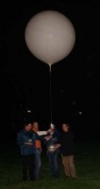
|
Sputnik-50
DA0SPUTNIK
balloon |
 On October
4th 2007 at 00:00 MESZ a balloon
was launched from a team of radio amateurs at the Sternwarte
Bochum/Germany. This is of course not really a satellite.
It carried a beacon with the callsign DA0SPUTNIK which
was transmitting information and audio recordings of
the first artificial satellite Sputnik-1 which had been
launched 50 years before. Sputnik-50 transmitted on
145.200 MHz in FM until about 01:46 MESZ. On the audio
file enclosed you can hear the last 5 minutes of transmissions
until the modulation finally stopped. Recorded on Oct
4th 2007 01:40 MESZ by DD1US
at a distance of approx. 300km. On October
4th 2007 at 00:00 MESZ a balloon
was launched from a team of radio amateurs at the Sternwarte
Bochum/Germany. This is of course not really a satellite.
It carried a beacon with the callsign DA0SPUTNIK which
was transmitting information and audio recordings of
the first artificial satellite Sputnik-1 which had been
launched 50 years before. Sputnik-50 transmitted on
145.200 MHz in FM until about 01:46 MESZ. On the audio
file enclosed you can hear the last 5 minutes of transmissions
until the modulation finally stopped. Recorded on Oct
4th 2007 01:40 MESZ by DD1US
at a distance of approx. 300km.
|
Oct 4th
2007 |
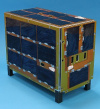
|
Cubesat
OSCAR 65
Cute-1.7 + APD II
CO-65
#32785
(2008-021C) |
The April 28th
2008 launch of 10 satellites aboard the Indian Space
Research Organization's (ISRO) Polar Satellite Launch
Vehicle-9 (PSLV-9) rocket included 7 amateur radio cubesat,
and 3 commercial/ scientific satellites. Cute-1.7 was
built by Tokyo Institute of Technology, Japan. The satellite
transmits a CW Morse Code beacon at 437.275 MHz using
FM modulation. It also features an FM FSK 9k6 / AFSK
1k2 (AX.25) downlink on 437.475MHz, The uplink frequency
is 1267.600MHz (FM FSK 9k6 AX.25). |
Apr
28th 2008 |
 The CW
beacon of CO-65 was received on 437.275 MHz on May 3rd
2008 by Paulo CT1ETE. Please note that a second satellite,
COMPASS-1, can be heard on the same recording as it
transmits on the same downlink frequency and was close
by. The CW signal of COMPASS-1 can be distinguished
by its chirping sound. Recording kindly provided by
Paulo CT1ETE. The CW
beacon of CO-65 was received on 437.275 MHz on May 3rd
2008 by Paulo CT1ETE. Please note that a second satellite,
COMPASS-1, can be heard on the same recording as it
transmits on the same downlink frequency and was close
by. The CW signal of COMPASS-1 can be distinguished
by its chirping sound. Recording kindly provided by
Paulo CT1ETE.
|
 The CW
beacon of CO-65 was received on 437.275 MHz on May 9th
2008 by Robert G8ATE. Please note that a second satellite,
COMPASS-1, can be heard on the same recording as it
transmits on the same downlink frequency and was close
by. The CW signal of COMPASS-1 can be distinguished
by its chirping sound. Recording kindly provided by
Robert G8ATE. The CW
beacon of CO-65 was received on 437.275 MHz on May 9th
2008 by Robert G8ATE. Please note that a second satellite,
COMPASS-1, can be heard on the same recording as it
transmits on the same downlink frequency and was close
by. The CW signal of COMPASS-1 can be distinguished
by its chirping sound. Recording kindly provided by
Robert G8ATE.
|
Cute-1.7+APD II also includes a CMOS
camera with a resolution of 640x480  pixels.
The picture of the Earth was taken on June 25th
2008 at 01:08:30 UTC and was received using the 9k6
AX.25 UHF downlink by Tokyo Tech. It was kindly provided
by Hiroki Ashida from the Lab. for Space Systems(LSS),
Tokyo Institute of Technology. pixels.
The picture of the Earth was taken on June 25th
2008 at 01:08:30 UTC and was received using the 9k6
AX.25 UHF downlink by Tokyo Tech. It was kindly provided
by Hiroki Ashida from the Lab. for Space Systems(LSS),
Tokyo Institute of Technology. |
 The CW
beacon was received on August 17th
2010 at 21:34 UTC on 437.275 MHz in CW mode by DD1US.
Please excuse the varying pitch of the CW signal due
to the strong doppler shift and manual frequency tuning
of the receiver. The CW
beacon was received on August 17th
2010 at 21:34 UTC on 437.275 MHz in CW mode by DD1US.
Please excuse the varying pitch of the CW signal due
to the strong doppler shift and manual frequency tuning
of the receiver.
|
 Cute-1.7+APD
II was received again on August 18th
2010 at 11:18 UTC on 437.2712 MHz in CW mode by DD1US.
You can clearly hear the beacon signal including "HI
HI de JQ1YTC ..." Cute-1.7+APD
II was received again on August 18th
2010 at 11:18 UTC on 437.2712 MHz in CW mode by DD1US.
You can clearly hear the beacon signal including "HI
HI de JQ1YTC ..."
|
 Cute-1.7+APD
II was still active in May 2013. Cute-1.7+APD
II was still active in May 2013.  Enclosed
CW beacon signal was received on May 9th
2013 at 09:53 UTC by M0YET. Recording and spectrum plot
kindly provided by Paul Marsh M0YET. Enclosed
CW beacon signal was received on May 9th
2013 at 09:53 UTC by M0YET. Recording and spectrum plot
kindly provided by Paul Marsh M0YET.
|
 In
August 2013 Mineo JE9PEL managed to digipeat via CO-65
using the uplink at 1267.600 MHz and the downlink at
437.475 MHz. The digipeater is usually activated during
the weekends. In
August 2013 Mineo JE9PEL managed to digipeat via CO-65
using the uplink at 1267.600 MHz and the downlink at
437.475 MHz. The digipeater is usually activated during
the weekends.
|
 The CW
beacon from CO-65 was received on May 1st
2015 at 08:38 UTC by Francisco EA7ADI. Recording kindly
provided by Francisco EA7ADI. The CW
beacon from CO-65 was received on May 1st
2015 at 08:38 UTC by Francisco EA7ADI. Recording kindly
provided by Francisco EA7ADI.
|
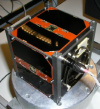
|
COMPASS-1
#32787
(2008-021E) |
COMPASS-1 is the first
Cubesat of the Aachen University of Applied Sciences,
Germany and has the callsign DP0COM. It is a 10x10x10
cm³ cubic satellite with a mass of less than 1
kilogram and was launched together with 6 other amateur
radio cubesats. The missions original purpose is to
let everyone take and download pictures of the earth
from the unique point of view of a satellite in orbit.
COMPASS-1 beacon transmits periodically every ~3 minutes
(every ~8 minutes during power safe) on its downlink
frequency of 437.275 MHz CW with a speed of ~15
WPM. Its telemetry and mission data downlink is on 437.405
MHz and can be activated by ground commands. It uses
1200bps (AFSK) (standard) or 2400/4800 (MSK) modulation
and the AX.25 protocol. |
Apr
28th 2008 |
 The audio
of the chirping CW beacon was received on 437.275 MHz
on May 3rd 2008 by Paulo CT1ETE.
Please note that a second satellite, Cute-1.7 + APD
II, can be heard on the same recording as it transmits
on the same downlink frequency and was close by. Recording
kindly provided by Paulo CT1ETE. The audio
of the chirping CW beacon was received on 437.275 MHz
on May 3rd 2008 by Paulo CT1ETE.
Please note that a second satellite, Cute-1.7 + APD
II, can be heard on the same recording as it transmits
on the same downlink frequency and was close by. Recording
kindly provided by Paulo CT1ETE.
|
 The audio
of the chirping CW beacon was received on 437.275 MHz
on May 9th 2008 by Robert G8ATE.
Please note that a second satellite, Cute-1.7 + APD
II, can be heard on the same recording as it transmits
on the same downlink frequency and was close by. Recording
kindly provided by Robert G8ATE. The audio
of the chirping CW beacon was received on 437.275 MHz
on May 9th 2008 by Robert G8ATE.
Please note that a second satellite, Cute-1.7 + APD
II, can be heard on the same recording as it transmits
on the same downlink frequency and was close by. Recording
kindly provided by Robert G8ATE.
|
 Here
is another recording of the CW beacon of Compass-1.
It was recorded on April 30th
2008. Here
is another recording of the CW beacon of Compass-1.
It was recorded on April 30th
2008.
|
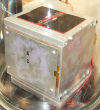
|
AAUSat-II
AAU-Cubesat
#32788
(2008-021F) |
 AAUSat-II
or AAU-Cubesat (Aalborg University Cubesat) was built
by Aalborg University, Denmark and was launched together
with 6 other amateur radio Cubesats. It will take pictures
of the surface of the Earth and particularly of Denmark
by using the on-board camera. The callsign is OZ2CUB
and it transmits on 437.425 MHz in the following modes:
USB, FFSK/MSK 1k2 1200Hz/1800Hz FX469 as well as CW
(beacon). The telemetry bursts, which are 1.6sec long
and transmitted every 30 sec, were recorded on May 16th
2008 at 20:25UTC by Mike DK3WN. Please note that the
pauses between the bursts were shortened in the enclosed
recording. AAUSat-II
or AAU-Cubesat (Aalborg University Cubesat) was built
by Aalborg University, Denmark and was launched together
with 6 other amateur radio Cubesats. It will take pictures
of the surface of the Earth and particularly of Denmark
by using the on-board camera. The callsign is OZ2CUB
and it transmits on 437.425 MHz in the following modes:
USB, FFSK/MSK 1k2 1200Hz/1800Hz FX469 as well as CW
(beacon). The telemetry bursts, which are 1.6sec long
and transmitted every 30 sec, were recorded on May 16th
2008 at 20:25UTC by Mike DK3WN. Please note that the
pauses between the bursts were shortened in the enclosed
recording.
|
Apr 28th
2008 |

|
Delfi-C3
OSCAR 64
Dutch OSCAR 64
#32789
(2008-021G) |
Delfi-C3 / DO-64 is the
first Nanosat built by students of Technical University
of Delft, Netherlands and was launched together with
6 other amateur radio Cubesats. Delfi-C3 has two VHF
telemetry downlinks: 145.930 MHz (Backup downlink 1200
Baud BPSK AX.25 400mW) and 145.870 MHz (Primary downlink
1200 Baud BPSK AX.25 400mW). You can decode telemetry
using the RASCAL freeware. Delfi-C3 includes also a
mode UV linear transponder which is expected to be activated
after the first 3 months of mission time. The Linear
transponder passbands are downlink 145.880 - 145.920
MHz (inverting, 400mW PEP), and uplink 435.570 - 435.530
MHz. While in transponder mode the beacon will be active
on 145.870 MHz in CW (10dB below transponder PEP). |
Apr
28th 2008 |
 This
audio file of the transponder was recorded by the Delfi-C3
team of the TU Delft while DO-64 was still in the clean-room
/ not yet launched. Thanks to Wouter Jan Ubbels PE4WJ
for kindly providing the file. This
audio file of the transponder was recorded by the Delfi-C3
team of the TU Delft while DO-64 was still in the clean-room
/ not yet launched. Thanks to Wouter Jan Ubbels PE4WJ
for kindly providing the file.
|
 This
audio file of the 1200 Baud BPSK AX.25 transmitter was
recorded on January 17th 2008 by the Delfi-C3 team of
the TU Delft while DO-64 was still in the clean-room
/ not yet launched. Thanks to Wouter Jan Ubbels PE4WJ
for kindly providing the file. This
audio file of the 1200 Baud BPSK AX.25 transmitter was
recorded on January 17th 2008 by the Delfi-C3 team of
the TU Delft while DO-64 was still in the clean-room
/ not yet launched. Thanks to Wouter Jan Ubbels PE4WJ
for kindly providing the file.
|
 On July
30th 2008 at 19:55h UTC Henk
PA3GUO made contact to SP9FPP in SSB using the linear
transponder of Delfi-C3. Uplink was 435.500 MHz and
downlink (as recorded) was 145.900 MHz. Due to a wrong
setting of the mp3 recorder the first part of the recording
is over-modulated. Many thanks to Henk PA3GUO for kindly
providing the recording. On July
30th 2008 at 19:55h UTC Henk
PA3GUO made contact to SP9FPP in SSB using the linear
transponder of Delfi-C3. Uplink was 435.500 MHz and
downlink (as recorded) was 145.900 MHz. Due to a wrong
setting of the mp3 recorder the first part of the recording
is over-modulated. Many thanks to Henk PA3GUO for kindly
providing the recording.
|
 The CW
beacon on 145.870 MHz was recorded on August 2nd
2008 at 9:50h UTC by Henk PA3GUO. The CW
beacon on 145.870 MHz was recorded on August 2nd
2008 at 9:50h UTC by Henk PA3GUO.
|

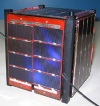
|
Cubesat
OSCAR 66
SEEDS-2
SEEDS-FM2
#32791
(2008-021J) |
SEEDS (Space Engineering
Educational Satellite) was built by Nihon University,
Japan and launched together with 6 other amateur radio
cubesats. Its main missions are sensing of the satellites
housekeeping data, analysis of its attitude and orbit,
and communication with the ground station. For communication
it uses the callsign JQ1YGU and transmits in various
modes on 437.485 MHz using a 1/4 wavelength monopole
antenna. The modes are CW (110mW), FM DigiTalker (450mW),
1200bd AFSK Packet Radio AX.25 (450mW), FM SSTV pictures
(450mW). If you are interested to analyze the status
of SEEDS-2, then you may want to download the free telemetry
data analyzer software from the Nihon University Cubesat
Project Official Website. |
Apr
28th 2008 |
 This
audio file of the Digitalker followed by a SSTV transmission
was recorded on 437.485 MHz on May 3rd
2008 at 10:15h UTC by Henk PA3GUO. This
audio file of the Digitalker followed by a SSTV transmission
was recorded on 437.485 MHz on May 3rd
2008 at 10:15h UTC by Henk PA3GUO.
|
  The
SSTV pictures on the right were received by Robert G8ATE
on May 3rd 2008 at 11:50 UTC
and on May 4th 2008 at 10:33h UTC on 437.485 MHz. The
SSTV pictures on the right were received by Robert G8ATE
on May 3rd 2008 at 11:50 UTC
and on May 4th 2008 at 10:33h UTC on 437.485 MHz.
|
 This
audio file of the Digitalker transmission was recorded
on May 6th 11:00h UTC by Robert
G8ATE. This
audio file of the Digitalker transmission was recorded
on May 6th 11:00h UTC by Robert
G8ATE.
|
 In this
audio file you can hear the CW beacon of CO-66 recorded
on 437.485 MHz on May 9th 2008
by Robert G8ATE. In this
audio file you can hear the CW beacon of CO-66 recorded
on 437.485 MHz on May 9th 2008
by Robert G8ATE.
|
 This
packet radio transmission was recorded on 437.485 MHz
on May15th 2008 at 12:20h UTC
by Robert G8ATE. This
packet radio transmission was recorded on 437.485 MHz
on May15th 2008 at 12:20h UTC
by Robert G8ATE.
|
 This packet
radio transmission was recorded on 437.475 MHz on July
27th 2009 at 02:23 UTC by Luc
LU1FAM. Luc used a 9 element yagi and an FM handheld
transceiver. This packet
radio transmission was recorded on 437.475 MHz on July
27th 2009 at 02:23 UTC by Luc
LU1FAM. Luc used a 9 element yagi and an FM handheld
transceiver.
|
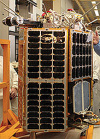
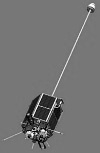
|
Yubileiny
RS-30
#32953
(2008-025A) |
Yubileiny (english: jubilee)
is a 45 kg small technology development satellite which
was built by NPO to commemorate the 50th
anniversary of the first artificial satellite launching.
The uplink frequency is 145.8 MHz. Using the callsign
RS-30 it transmits information on the history of space
development and Russian cosmonauts achievements, which
Radio amateurs around the world were able to receive
on 435.215 MHz and 435.315 MHz. The satellite transmits
a cyclic series of messages lasting for 4 minutes including
a call signal and TM-data (10 seconds); a voice message
(1 minute); a pause (50 seconds); the first artificial
satellite imitated signals (10 seconds); an SSTV image
(1 minute); with a final pause (50 seconds). |
May
23rd 2008 |
 The 4
min transmission enclosed was recorded on May 24th
2008 at 18:15h UTC in FM mode by Robert G8ATE. It does
not really fit the cyclic plan as explained above The 4
min transmission enclosed was recorded on May 24th
2008 at 18:15h UTC in FM mode by Robert G8ATE. It does
not really fit the cyclic plan as explained above
|
 This
CW beacon signal of RS-30 was recorded on May 25th
2008 by Mark KF6KYI. This
CW beacon signal of RS-30 was recorded on May 25th
2008 by Mark KF6KYI.
|
 The CW
beacon signal of RS-30 was also recorded on May 26th
2008 by Mike DK3WN. Please note that the pauses between
the bursts were shortened in the enclosed recording. The CW
beacon signal of RS-30 was also recorded on May 26th
2008 by Mike DK3WN. Please note that the pauses between
the bursts were shortened in the enclosed recording.
|
 On October
4th 2008, in memoriam of Sputnik-1's 51st anniversary,
Yubileiny transmitted the Russian national anthem, signals
of Sputnik-1 and associated comments in Russian language.
The signal of RS-30 in orbit 1664 was recorded on 435.215
MHz by Thomas HB9SKA. Please note that this 12 minutes
recording is 13MByte large ! On October
4th 2008, in memoriam of Sputnik-1's 51st anniversary,
Yubileiny transmitted the Russian national anthem, signals
of Sputnik-1 and associated comments in Russian language.
The signal of RS-30 in orbit 1664 was recorded on 435.215
MHz by Thomas HB9SKA. Please note that this 12 minutes
recording is 13MByte large !
|
 On November
6th 2010 at 16:25h UTC Patrick
received enclosed transmission of RS-30 on 435.320.720
MHz in FM mode using his FT-817ND transceiver. Thanks
for sharing the recording with us ! On November
6th 2010 at 16:25h UTC Patrick
received enclosed transmission of RS-30 on 435.320.720
MHz in FM mode using his FT-817ND transceiver. Thanks
for sharing the recording with us !
|

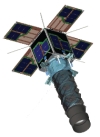
|
PRISM
HITOMI
JQ1YZW
#33493
(2009-002B) |
PRISM (HITOMI) is a 5
kg pico satellite which was jointly launched together
with 6 other satellites piggyback on GOSAT. It was built
by the University of Tokyo and its mission is remote
sensing and other experiments. PRISM went successfully
in operation and took images with a resolution higher
than 30m.
PRISM also includes an
amateur radio payload. It transmits a 80mW CW beacon
on 437.250 MHz using the callsign JQ1YZW. It also features
a dual mode packet radio downlink on 437.425 MHz. This
downlink transmits either 1200bd AFSK AX-25 data with
800mW output power or 9600bd GMSK AX-25 data with 2W
output power.
On October 17th
2012 the two primary missions of PRISM was completed
and PRISM was released for general ham radio use. It
uses now the AFSK1200 (AX.25 non repeater mode, UI frames)
on the downlink frequency of 437.425 MHz and also transmits
the CW beacon on 437.250 MHz. The uplink frequency is
in the 2m band and can be obtained after agreeing to
the term os usage on the following website: http://www.space.t.u-tokyo.ac.jp/prism/en/main.html |
Jan
23rd 2009 |
 The CW
beacon signal was recorded on January 30th
2009 at 01:03 UTC and kindly provided by Paulo CT1ETE. The CW
beacon signal was recorded on January 30th
2009 at 01:03 UTC and kindly provided by Paulo CT1ETE.
|
 This recording
of the 9600bd GMSK transmission of PRISM was made by
JA0CAW on July 23rd 2009 at
23h45 UTC. Many thanks to Tetsu-san JA0CAW for kindly
providing the recording. This recording
of the 9600bd GMSK transmission of PRISM was made by
JA0CAW on July 23rd 2009 at
23h45 UTC. Many thanks to Tetsu-san JA0CAW for kindly
providing the recording.
|
 On April
6th 2014 Davide IW0HLG received
the CW signal of PRISM on 437.250 MHz. Recording kindly
provided by Davide IW0HLG. On April
6th 2014 Davide IW0HLG received
the CW signal of PRISM on 437.250 MHz. Recording kindly
provided by Davide IW0HLG.
|
 The CW
beacon signal from PRISM was recorded on February 2nd
2015 at 18:48 UTC and kindly provided by Francisco AE7ADI. The CW
beacon signal from PRISM was recorded on February 2nd
2015 at 18:48 UTC and kindly provided by Francisco AE7ADI.
|
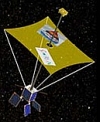
|
KAGAYAKI
SORUNSAT-1
#33495
(2009-002D) |
SORUNSAT-1
is a 20 kg microsatellite and was launched together
with 6 other satellites piggyback on GOSAT. Besides
its scientific mission it includes a small camera at
the end of the deployable boom which will enable disabled
children to see their artwork, placed on the deployed
membrane, in space. SORUNSAT-1 includes an amateur radio
payload and is supposed to transmit signals in CW and
9600bd FSK AX-25 packets on 437.375 MHz.
I am searching for sound files. Please
send them to
 |
Jan 23rd
2009 |
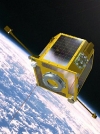
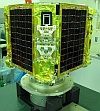
|
SOHLA-1
MAIDO-1
#33496
(2009-002E) |
SOHLA-1 (Space Oriented
Higashiosaka Leading Association 1) is a 50kg microsatellite
and was launched together with 6 other satellites piggyback
on GOSAT. SOHLA-1 includes an amateur radio payload
and transmits 1200bd AFSK AX-25 packets on 437.505 MHz.
Its 1 W transmitter also transmits sometimes CW on the
same frequency using the callsign JL3YUS. |
Jan
23rd 2009 |
 This recording
of the 1200bd AFSK AX-25 packet transmission in HI mode
of SOHLA-1 was made by JA0CAW on July 4th
2009 at 23h48 UTC. Many thanks to Tetsu-san JA0CAW for
kindly providing the recording. This recording
of the 1200bd AFSK AX-25 packet transmission in HI mode
of SOHLA-1 was made by JA0CAW on July 4th
2009 at 23h48 UTC. Many thanks to Tetsu-san JA0CAW for
kindly providing the recording.
|
 This recording
of the 1200bd AFSK AX-25 packet transmission in normal
mode of SOHLA-1 was made by JA0CAW on July 8th
2009. Many thanks to Tetsu-san JA0CAW for kindly providing
the recording. This recording
of the 1200bd AFSK AX-25 packet transmission in normal
mode of SOHLA-1 was made by JA0CAW on July 8th
2009. Many thanks to Tetsu-san JA0CAW for kindly providing
the recording.
|

|
STARS
1
KUKAI
#33498
(2009-002G) |
STARS 1 is a tethered
pair of satellites (mother and daughter) which were
launched together with 6 other satellites piggyback
on GOSAT. The mother satellite named KU and the daughter
satellite called KAI separated after having been jointly
released from the H-IIA F15 launcher. The tethered satellite
pair communicates using a wireless Bluetooth link. Stars
includes two amateur radio payloads:
The mother
satellite KU transmits a CW beacon on 437.305 MHz using
the callsign JR5YBN. It also features a 1200bd AFSK
AX-25 downlink on 437.485 MHz.
The daughter satellite
KAI transmits a CW beacon on 437.2725 MHz using the
callsign JR5YBO. It also features a 1200bd AFSK AX-25
downlink on 437.465 MHz. |
Jan
23rd 2009 |
 The CW
beacon signal of the daughter satellite JR5YBO was recorded
on January 30th 2009 at 00:30
UTC by Paulo CT1ETE. The CW
beacon signal of the daughter satellite JR5YBO was recorded
on January 30th 2009 at 00:30
UTC by Paulo CT1ETE.
|
 The mother
satellite KU was received on August 2nd
2010 at 23:20 UTC on 437.301 MHz in CW mode by Matthias
DD1US. You can identify in the weak CW signal the sequence
"hello, world." The mother
satellite KU was received on August 2nd
2010 at 23:20 UTC on 437.301 MHz in CW mode by Matthias
DD1US. You can identify in the weak CW signal the sequence
"hello, world."
|
  On July 20th 2014 at 13:28
UTC Davide IW0HLG received the CW signal of the mother
satellite KU on 437.305 MHz. Recording and waterfall
plot kindly provided by Davide IW0HLG.
On July 20th 2014 at 13:28
UTC Davide IW0HLG received the CW signal of the mother
satellite KU on 437.305 MHz. Recording and waterfall
plot kindly provided by Davide IW0HLG.
|
  On July 20th 2014 at 14:03
UTC Davide IW0HLG received the CW signal of the daughter
satellite KAI on 437.275 MHz. Recording and waterfall
plot kindly provided by Davide IW0HLG.
On July 20th 2014 at 14:03
UTC Davide IW0HLG received the CW signal of the daughter
satellite KAI on 437.275 MHz. Recording and waterfall
plot kindly provided by Davide IW0HLG.
|
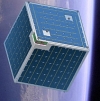
|
KKS-1
#33499
(2009-002H) |
KKS-1 is a 3 kg cubesat
and was launched together with 6 other satellites piggyback
on GOSAT. It is a small, educational technology satellite
built by the Tokyo Metropolitan College of Industrial
Technology. Its purpose is to conduct experiments on
micro-thrusters and on 3-axis attitude control. In addition
it will take land images. KKS-1 includes an amateur
radio payload comprised of a CW beacon on 437.385 MHz
using the callsign JQ1YYYand of a 1200bd AFSK AX-25
downlink on 437.445 MHz. |
Jan
23rd 2009 |
 The CW
beacon signal transmitting the message ""HELLO
THIS IS KKS-1" was recorded on January 30th
2009 at 00:34 UTC by Paulo CT1ETE. The CW
beacon signal transmitting the message ""HELLO
THIS IS KKS-1" was recorded on January 30th
2009 at 00:34 UTC by Paulo CT1ETE.
|
  On
July 21st 2014 Davide IW0HLG
received the CW signal of KKS-1 on 437.385 MHz. Recording
kindly provided by Davide IW0HLG. On
July 21st 2014 Davide IW0HLG
received the CW signal of KKS-1 on 437.385 MHz. Recording
kindly provided by Davide IW0HLG.
|
 On March
30th 2015 at 14:42 UTC Francisco
EA7ADI received the CW signal of KKS-1. Recording kindly
provided by Francisco EA7ADI. On March
30th 2015 at 14:42 UTC Francisco
EA7ADI received the CW signal of KKS-1. Recording kindly
provided by Francisco EA7ADI.
|
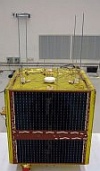
|
ANUSAT
#34808
(2009-019B) |
ANUSAT (Anna University Satellite)
is the first satellite built by an Indian University
under the overall guidance of ISRO (Indian Space Research
Organisation) to demonstrate the technologies related
to message store and forward operations. The Amateur
Radio payload of this 40kg micro-satellite is a 145
MHz uplink / 435 MHz downlink (4W) Digital Store and
Forward system. In addition it features a tele-command
VHF receiver (PCM, FSK/AM modulation, 100 bits/sec,
149.522 or 149.2 MHz tbd) as well as a VHF telemetry
transmitter (digital PSK/PM modulation, 256 bits/sec.,
137.4 MHz, 0.5W). |
April
20th 2009 |
 Enclosed
signal from ANUSAT was received on October 19th
2009 on one of the sidebands of the 137.400 MHz signals.
Recorded and kindly provided by Maik Hermenau. Enclosed
signal from ANUSAT was received on October 19th
2009 on one of the sidebands of the 137.400 MHz signals.
Recorded and kindly provided by Maik Hermenau.
|
 Enclosed
signal from ANUSAT was received on August 13th
2010 on one of the sidebands of the 137.400 MHz signals.
Recorded and kindly provided by Maik Hermenau. Enclosed
signal from ANUSAT was received on August 13th
2010 on one of the sidebands of the 137.400 MHz signals.
Recorded and kindly provided by Maik Hermenau.
|
 Enclosed
signal from ANUSAT was received on August 17th
2010 on 137.400 MHz. Recorded and kindly provided by
Maik Hermenau. Enclosed
signal from ANUSAT was received on August 17th
2010 on 137.400 MHz. Recorded and kindly provided by
Maik Hermenau.
|

|
DK0SB/AM
balloon experiment |
 On July
17th 2009 a balloon was lainched
from Sternwarte (observatory) Bochum/Germany a beacon
with the callsign DK0SB/AM (AM = aeronautical mobile).
This ARTOB (amateur radio transmitter on Balloon) experiment
was launched in memoriam of the first man on the moon
on July 17th 1969 (40 years ago). Recorded on July 17th
2009 at 21:00 UTC on 145.200 MHz in FM by Nils von Storch. On July
17th 2009 a balloon was lainched
from Sternwarte (observatory) Bochum/Germany a beacon
with the callsign DK0SB/AM (AM = aeronautical mobile).
This ARTOB (amateur radio transmitter on Balloon) experiment
was launched in memoriam of the first man on the moon
on July 17th 1969 (40 years ago). Recorded on July 17th
2009 at 21:00 UTC on 145.200 MHz in FM by Nils von Storch.
|
July 17th
2009 |
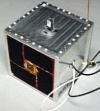
|
AGGIESAT-2
#35690
(2009-038B) |
On July 30th
2009 the DRAGONSAT-2 (Dual RF Astrodynamic GPS Orbital
Navigator Satellite) project was released from Space
Shuttle Endeveaur (STS-127). It consists of 2 sister
satellites BEVO-1 and AGGIESAT-2. AGGIESAT´s downlink
frequency is 436.250 MHz and it uses a proprietary modem
protocol as the main radio is a COTS data modem. It
appears that the only way to decipher the code is to
have a model MHX425 that can speak the proprietary language.
The radio data rate is actually at 19200 bps. |
July
30th 2009 |
 The audio
file of AGGIESAT-2 was recorded by Mike DK3WN on July
30th 2009 at 16:04 UTC during
the 2nd orbit of AGGIESAT-2. The audio
file of AGGIESAT-2 was recorded by Mike DK3WN on July
30th 2009 at 16:04 UTC during
the 2nd orbit of AGGIESAT-2.
|
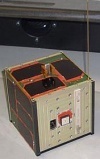
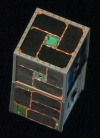
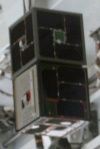
|
BEVO-1
#35690
(2009-038B) |
BEVO-1 was deployed together
with its sister satellite AGGIESAT-2 from Space Shuttle
mission 127 on July 30th 2009
at 12:34:50 UTC as part of the DRAGONSAT program. It
is a picosat mission of the University of Texas to test
a GPS unit designed and built by NASA. Texas A&M
and the University of Texas were required to build 5"
cubesat spacecraft buses and support systems for the
GPS units.
Beacon Mode
Downlink Frequency: 437.325
MHz
Modulation: FM, 200mW, Morse Code, ~20 WPM
Data Mode
Downlink Frequency: 437.325 MHz
Modulation:
FSK, 1W, 9600 baud, AX.25 (default) or FM, 1W, Bell
202, AX.25. |
July
30th 2009 |
Status as of August 5th
2009: Still no signals from BEVO1, although beacon packets
were heard from AGGIESAT2. The current theory on the
state of the satellites is that only partial separation
occurred. The inhibit switches keeping the satellites
powered off have been closed, allowing the satellites
to boot up. However, it is likely that the antennas
did not deploy correctly, leaving the antennas disconnected
from their respective transmitters. AGGIESAT2 transmits
with 1W of power so it is easier to hear, while BEVO1
only transmits with 200mW during beacon mode. |
Unfortunately
the 2 satellites did not separate after they were released
from the space shuttle you will find only one single
set of Keplerian elements referred to as "DRAGONSAT".
On the left you can also see 2 pictures where AGGIESAT-2
(top) and BEVO-1 (bottom) are shown still attached to
each other after launch. |

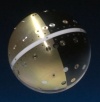
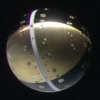
|
Castor
#35694
(2009-038F) |
 On July
30th 2009 the ANDE-2 (Atmospheric
Neutral Density Experiment) project was released from
Space Shuttle Endeveaur (STS-127). It consists of 2
spherical satellites called Castor and Pollux fitted
with retro-reflectors for satellite laser ranging (SLR).
The constant and well-determined cross section and surface
properties of the ANDE spacecrafts provide an ideal
set of objects for monitoring atmospheric drag and the
calibration of space surveillance network (SSN) assets
both radar and optical. On July
30th 2009 the ANDE-2 (Atmospheric
Neutral Density Experiment) project was released from
Space Shuttle Endeveaur (STS-127). It consists of 2
spherical satellites called Castor and Pollux fitted
with retro-reflectors for satellite laser ranging (SLR).
The constant and well-determined cross section and surface
properties of the ANDE spacecrafts provide an ideal
set of objects for monitoring atmospheric drag and the
calibration of space surveillance network (SSN) assets
both radar and optical.
Castor-1 is a 49cm diameter
aluminum sphere with a mass of 63 kg. It tramsmits telemetry
on 145.825 MHz using the callsign KD4HBO-1. Enclosed
audiofile which contains signals from Castor and Pollux
was recorded by Mike DK3WN during orbit no.1 on July
30th 2009 at 17:44 UTC.
|
July 30th
2009 |

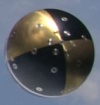
|
Pollux-1
#35693
(2009-038E) |
 On July
30th 2009 the ANDE-2 project
was released from Space Shuttle Endeveaur (STS-127).
It consists of 2 satellites called Castor and Pollux. On July
30th 2009 the ANDE-2 project
was released from Space Shuttle Endeveaur (STS-127).
It consists of 2 satellites called Castor and Pollux.
Pollux-1 transmits every 33 seconds a telemetry
packet on 145.825 MHz in FM/AFSK using 1200bd with F.25
(FEC) on top of AX.25. It also has the possibility to
transmit 9600bd packet radio signals and test GMSK modulation.
Pollux´s transmit frequency is about 1.5 to 2
khz higher than Castor´s. Furthermore the signal
of Pollux is stronger than Castor´s signal in
spite of the fact that they should use the same transmit
power of up to 1W. Enclosed audiofile which contains
signals from Castor and Pollux was recorded by Mike
DK3WN during orbit no.1 on July 30th
2009 at 17:44 UTC.
|
July 30th
2009 |
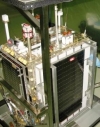
|
Sumbandilasat
OSCAR 67
SO-67
(ZA-002)
#35870
(2009-049F) |
SumbandilaSat
is sponsored by the South African Department of Science
and Technology and was built at SunSpace in cooperation
with the Stellenbosch University. It uses the callsign
ZS0SUM for its 3 ham radio communication systems: a
voice beacon (UHF downlink is 435.300 MHz), a parrot
repeater and a VHF/UHF FM repeater. Both repeater operate
with a VHF uplink at 145.880 MHz and a UHF downlink
at 435.350 MHz. |
Sept
17th 2009 |
 The amateur
radio payload of SO-67 was first time successfully switched
on from the ground by ZS6BPZ during a test phase on
Sunday October 18th 2009. During
the first evening pass of that day over South Africa
at 19:13h UTC the FM transponder was activated. It was
found out that the actual center frequencies for up-
and downlink were about 5kHZ shifted down. Thus the
uplink frequency was 145.875 MHz, the downlink frequency
was 435.345 MHz, the CTCSS tone to be used was 233.6
Hz. Enclosed recording of this successful first test
of the SO-67 transponder was done and kindly provided
by Pierre ZS6BB. The amateur
radio payload of SO-67 was first time successfully switched
on from the ground by ZS6BPZ during a test phase on
Sunday October 18th 2009. During
the first evening pass of that day over South Africa
at 19:13h UTC the FM transponder was activated. It was
found out that the actual center frequencies for up-
and downlink were about 5kHZ shifted down. Thus the
uplink frequency was 145.875 MHz, the downlink frequency
was 435.345 MHz, the CTCSS tone to be used was 233.6
Hz. Enclosed recording of this successful first test
of the SO-67 transponder was done and kindly provided
by Pierre ZS6BB.
|
 On November
7th 2009 the FM V/U cross-band
transponder was also activated for 13 minutes during
a pass over Europe. Recorded on 435.345 MHz in FM on
November 7th 2009 at 08:20h
UTC by DD1US. On November
7th 2009 the FM V/U cross-band
transponder was also activated for 13 minutes during
a pass over Europe. Recorded on 435.345 MHz in FM on
November 7th 2009 at 08:20h
UTC by DD1US.
|
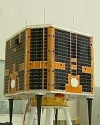
|
Hope
OSCAR 68
HO-68
XW-1
XIWANG-1
CAS-1
HOPE-1
#36122
(2009-072B) |
XW-1 / HO-68 is a Microsatellite
built by the Chinese AMSAT group CAMSAT. Its weight
is 50kg and the dimensions are: diameter 68cm, height
43.2cm. Its 145 MHz uplink RX antenna is LHCP
with a gain of 2 dBi. The downlink TX antenna for 435
MHz is RHCP with a gain of 3 dBi. It was launched as
a secondary payload aboard the CZ-4C rocket from Taiyuan
Satellite Launch Center on December 15th 2009 into a
1200km circular sun synchronous orbit with an inclination
of 105°.
XW-1 uses the callsign BJ1SA and features
the following modes:
- Mode V/U (J) FM Voice Repeater
(30 dBm):
Uplink:
145.8250 MHz FM, PL 67.0 Hz
Downlink:
435.6750 MHz FM
- Mode V/U (J) Lin. Invert. Transponder
(30 dBm):
Uplink:145.9250
- 145.9750 MHz SSB/CW
Downlink:435.7650
- 435.7150 MHz SSB/CW
- Mode V/U (J) PacSat BBS
(30 dBm):
Uplink:145.8250
MHz AFSK 1200 BPS
Downlink:
435.6750 MHz AFSK 1200 BPS
- Mode Beacon (23 dBm):
Downlink:435.7900 MHz
CW |
Dec
15th 2009 |
 The beacon
signal was received and recorded on December 15th
2009 at 20:27UTC in USB on 435.782 MHz by DD1US. The beacon
signal was received and recorded on December 15th
2009 at 20:27UTC in USB on 435.782 MHz by DD1US.
|
 The FM
Voice Repeater downlink including the signal of LZ1JH
was received and recorded on December 29th
2009 at 18:18UTC in FM on 435.672 MHz by DD1US. The FM
Voice Repeater downlink including the signal of LZ1JH
was received and recorded on December 29th
2009 at 18:18UTC in FM on 435.672 MHz by DD1US.
|
 On January
8th 2010 SQ7DQX had a nice
contact with VA3FM. Recorded on January 8th
2010 at 22:40UTC by SQ7DQX. On January
8th 2010 SQ7DQX had a nice
contact with VA3FM. Recorded on January 8th
2010 at 22:40UTC by SQ7DQX.
|
 This CW
signal from HO-68 was received on April 11th
2015 at 09:21 UTC by Francisco EA7ADI. Recording kindly
provided by Francisco EA7ADI. This CW
signal from HO-68 was received on April 11th
2015 at 09:21 UTC by Francisco EA7ADI. Recording kindly
provided by Francisco EA7ADI.
|
  Also
on August 15th 2015 at 08:01
UTC Francisco EA7ADI received the CW signal from HO-68
on 437.790 MHz. Recording and audiogramm kindly provided
by Francisco EA7ADI. Also
on August 15th 2015 at 08:01
UTC Francisco EA7ADI received the CW signal from HO-68
on 437.790 MHz. Recording and audiogramm kindly provided
by Francisco EA7ADI.
|
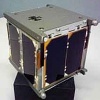
|
Waseda-SAT2
#36574
(2010-020B) |
 Waseda-SAT2
was built by students at Waseda University in Japan
and launched together with Planet-C but only in a 300km
LEO. Due to the low inclination it will not be possible
to receive it in Germany. The 1.2 kg cubesat features
a camera for Earth observations and will transmit a
beacon on the downlink frequency of 437.485 MHz. The
modulation will be 9600bd PCMFSK and CW. Waseda-SAT2
was built by students at Waseda University in Japan
and launched together with Planet-C but only in a 300km
LEO. Due to the low inclination it will not be possible
to receive it in Germany. The 1.2 kg cubesat features
a camera for Earth observations and will transmit a
beacon on the downlink frequency of 437.485 MHz. The
modulation will be 9600bd PCMFSK and CW.
|
May 20th
2010 |
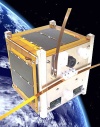
|
Negai*"
#36575
(2010-020C) |
Negai*" (Negai-Star)
was built by students at Soka University in Japan and
launched together with Planet-C but only in a 300km
LEO. Due to the low inclination it will not be possible
to receive it in Germany. The 1 kg cubesat transmits
a beacon on the downlink frequency of 437.305 MHz using
the callsign JQ1ZEX. The modulation is 1200bps AFSK
(0.4W) or CW (0.1W). |
May
20th 2010 |
 On May
29th 2010 around 14:55 UTC
Mike DK3WN and Tetsu-san JA0CAW made an exciting experiment.
They established a live link between their stations
and Mike could thus operate Tetsu-san's station They
were using Skype for the audio and VNC to control the
PCs and TRX remotely. Thus Mike could receive and record
the excellent CW beacon of NEGAI* in Central Europe
while the satellite was over the Pacific Ocean. Thanks
to Mike for kindly providing the recording. On May
29th 2010 around 14:55 UTC
Mike DK3WN and Tetsu-san JA0CAW made an exciting experiment.
They established a live link between their stations
and Mike could thus operate Tetsu-san's station They
were using Skype for the audio and VNC to control the
PCs and TRX remotely. Thus Mike could receive and record
the excellent CW beacon of NEGAI* in Central Europe
while the satellite was over the Pacific Ocean. Thanks
to Mike for kindly providing the recording.
|
 This recording
of the 1200bd AFSK AX-25 packet transmission of Negai
was made by JA6PL on June 10th
2010. Many thanks to Tetsu-san JA0CAW for kindly providing
the recording. This recording
of the 1200bd AFSK AX-25 packet transmission of Negai
was made by JA6PL on June 10th
2010. Many thanks to Tetsu-san JA0CAW for kindly providing
the recording.
|
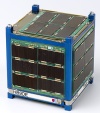
|
TIsat-1
HB9DE
#36799
(2010-035E) |
TISat-1 is a Swiss Cubesat
and part of the Nanosatellite Launch Service 6 (NLS-6)
cluster payload from the Space Flight Laboratory (SFL)
at the University of Toronto, Institute for Aerospace
Studies (UTIAS). TIsat-1 was successfully launched with
the 17th flight launch of Indian
space agency's Polar Satellite Launch Vehicle PSLV-C
15 from Sriharikota spaceport on July 12th
2010.
Its communication systems are:
Uplink:
145.980 MHz FM
Downlink: 145.980 MHz
FM, AFSK, PSK
Beacon: 437.305 MHz (400mW)
CW
Callsign: HB9DE |
July
12th 2010 |
 Enclosed
recording is from the first pass of TIsat-1 HB9DE over
the ground station of SUPSI Radio Club, HB9SRC in Manno,
Ticino, Switzerland. TISat-1 was tracked and received
on July 12th 2010 at 08:43
UTC by the students and ground segment team just few
hours after the launch. The CW beacon transmitting Morse
Code with 17WPM was received on 437.305 MHz. Recording
kindly provided by Ivano Bonesana from SUPSI SpaceLab. Enclosed
recording is from the first pass of TIsat-1 HB9DE over
the ground station of SUPSI Radio Club, HB9SRC in Manno,
Ticino, Switzerland. TISat-1 was tracked and received
on July 12th 2010 at 08:43
UTC by the students and ground segment team just few
hours after the launch. The CW beacon transmitting Morse
Code with 17WPM was received on 437.305 MHz. Recording
kindly provided by Ivano Bonesana from SUPSI SpaceLab.
|
 Enclosed
CW beacon signal "HI HI HI TISAT K" with K
indicating a temperature of the satellite of 0°C
on 437.305 MHz was recorded on July 29th
2010 at 22:14 UTC by DD1US. Enclosed
CW beacon signal "HI HI HI TISAT K" with K
indicating a temperature of the satellite of 0°C
on 437.305 MHz was recorded on July 29th
2010 at 22:14 UTC by DD1US.
|
 Enclosed
CW beacon signal "HI HI HI TISAT B" with B
indicating a temperature of the satellite of -5°C
on 437.297 MHz was recorded on August 27th
2010 at 09:36 UTC by Patrick Hajagos. Enclosed
CW beacon signal "HI HI HI TISAT B" with B
indicating a temperature of the satellite of -5°C
on 437.297 MHz was recorded on August 27th
2010 at 09:36 UTC by Patrick Hajagos.
|
 Also on
September 11th 2010 at 11:45h
UTC Patrick received the CW beacon signal "HI HI
HI TISAT B" on 437.300 MHz. This time he had improved
his antenna system and the signal was thus stronger.
Recording kindly provided by Patrick Hajagos. Also on
September 11th 2010 at 11:45h
UTC Patrick received the CW beacon signal "HI HI
HI TISAT B" on 437.300 MHz. This time he had improved
his antenna system and the signal was thus stronger.
Recording kindly provided by Patrick Hajagos.
|
 On October
18th 2014 at 00:38 UTC Francisco
EA7ADI received the CW signal of TiSAT-1. Recording
kindly provided by Francisco EA7ADI. On October
18th 2014 at 00:38 UTC Francisco
EA7ADI received the CW signal of TiSAT-1. Recording
kindly provided by Francisco EA7ADI.
|

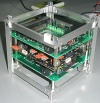
|
StudSat
#36801
(2010-035G) |
StudSat (Student Satellite)
is an Indian CubeSat. After the successful launch with
the 17th flight launch of Indian
space agency's Polar Satellite Launch Vehicle PSLV-C
15 from Sriharikota spaceport and separation from the
launcher the beacon signal was first received on July
12th 2010 at 05:02 UTC by the
tracking station in NMIT (India).
Its communication
systems are:
Up- and Downlink: 437.505MHz, 9600bps
FSK, half duplex
Beacon: 437.861 MHz (10 mW), 20bps
ASK Morse Code |
July 12th
2010 |


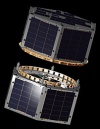
|
FASTRAC
(2010-062F)
|
FASTRAC (Formation Autonomy
Spacecraft with Thrust, Relnav, Attitude and Crosslink)
is a pair of nanosatellites developed and built by students
at The University of Texas at Austin. The combined weight
of the 2 satellites FASTRAC 1 with the nickname "Sara
Lily" and FASTRAC 2 with the nickname "Emma"
is 55kg. They were launched together with RAX on November
20th 2010 at 01:25 UTC from
Kodiak Launch Complex in Kodiak, Alaska. FAST1 and FAST2
were separated on March 22nd
2011 at 11:35 UTC and subsequently FAST2 got its own
international designation number (NORAD #37380). |
Nov
20th 2010 |
FASTRAC-1
FAST1
FASTRAC OSCAR-69
FO-69
USA 222
#37227
Sara-Lily
Nanosat 3A
|
FASTRAC OSCAR-69 transmits
every 3 minutes a 1200bd AX.25 AFSK beacon on 437.345
MHz using the callsign FAST1. The same transmitter can
also be used for 9600bd GMSK and will be especially
used for inter-satellite communication to FASTRAC 2.
It has 2 uplink channels which are 145.825 MHz FM 1200bd
and 145.980 MHz FM 1200bd and/or 9600bd.
 FASTRAC-1
was received on November 20th
2010 at 04:20 UTC on 437.345 MHz by Mike DK3WN. This
was probably the first successful reception of FASTRAC-1.
You can hear multiple short 9600bd GMSK bursts (with
GPS data) which are transmitted from FASTRAC-1 to FASTRAC-2
and one burst of the 1200bd AFSK downlink signal. The
1200bd downlink signal has rather low volume as the
deviation of the AFSK signal is lower and the receiver
bandwidth was adjusted to the 9600bd FSK signal. Recording
kindly provided by Mike DK3WN. FASTRAC-1
was received on November 20th
2010 at 04:20 UTC on 437.345 MHz by Mike DK3WN. This
was probably the first successful reception of FASTRAC-1.
You can hear multiple short 9600bd GMSK bursts (with
GPS data) which are transmitted from FASTRAC-1 to FASTRAC-2
and one burst of the 1200bd AFSK downlink signal. The
1200bd downlink signal has rather low volume as the
deviation of the AFSK signal is lower and the receiver
bandwidth was adjusted to the 9600bd FSK signal. Recording
kindly provided by Mike DK3WN. |
On December 2nd
2011 the ham radio digipeater of FAST1 was activated.
Up- and Downlink are both 9600bd with the uplink frequency
being 145.980 MHz and the downlink frequency being 437.345
MHz. |
FASTRAC-2
FAST2
FASTRAC OSCAR-70
FO-70
USA 228
#37380
Emma
Nanosat 3B |
FASTRAC OSCAR-70 transmits
every 3 minutes a 1200bd AX.25 AFSK beacon on 145.825
MHz using the callsign FAST2. The same transmitter can
also be used for 9600bd GMSK and will be especially
used for inter-satellite communication to FASTRAC 1.
It has 2 uplink channels which are 435.025 MHz FM 1200bd
and 437.345 MHz FM 9600bd.
 FASTRAC-2
was received on November 20th
2010 at 06:00 UTC on 145.825 MHz by Mike DK3WN. Mike's
decoded data were the first officially recorded data.
You can hear multiple short 9600bd bursts (with GPS
data) which are transmitted from FASTRAC-2 to FASTRAC-1
and one burst of the 1200bd downlink signal. The 1200bd
downlink signal has rather low volume as the deviation
of the AFSK signal is lower and the receiver bandwidth
was adjusted to the 9600bd FSK signal. Recording kindly
provided by Mike DK3WN. FASTRAC-2
was received on November 20th
2010 at 06:00 UTC on 145.825 MHz by Mike DK3WN. Mike's
decoded data were the first officially recorded data.
You can hear multiple short 9600bd bursts (with GPS
data) which are transmitted from FASTRAC-2 to FASTRAC-1
and one burst of the 1200bd downlink signal. The 1200bd
downlink signal has rather low volume as the deviation
of the AFSK signal is lower and the receiver bandwidth
was adjusted to the 9600bd FSK signal. Recording kindly
provided by Mike DK3WN. |


|
Caerus
Mayflower-Caerus
#37252
(2010-066J) |
 CAERUS
(greek "opportunity) is the first nano-satellite
subsystem built by the University of Southern California,
USA. Caerus is a "1U" cubesat and was built
in 14 weeks. Together wit the "MAYFLOWER"
"2U" Cubesat module it is part of a Next Generation
Technology "3U" Nanosatellite. Mayflower-Caerus
was successfully launched on December 8th
2010 by a two-stage SpaceX Falcon 9 rocket into a LEO
circular orbit with 34° inclination. It features
a 1200bd AFSK beacon downlink at 437.600 MHz and uses
the callsign KJ6FIX. The beacon is transmitting every
10 seconds, has an output power of 900mW and uses a
quad monopole antenna. Mayflower-Caerus reentered on
December 22nd 2010. Enclosed
recording from Tetsu-san JA0CAW dated Dec 9th
2010 was kindly provided by Mike DK3WN. CAERUS
(greek "opportunity) is the first nano-satellite
subsystem built by the University of Southern California,
USA. Caerus is a "1U" cubesat and was built
in 14 weeks. Together wit the "MAYFLOWER"
"2U" Cubesat module it is part of a Next Generation
Technology "3U" Nanosatellite. Mayflower-Caerus
was successfully launched on December 8th
2010 by a two-stage SpaceX Falcon 9 rocket into a LEO
circular orbit with 34° inclination. It features
a 1200bd AFSK beacon downlink at 437.600 MHz and uses
the callsign KJ6FIX. The beacon is transmitting every
10 seconds, has an output power of 900mW and uses a
quad monopole antenna. Mayflower-Caerus reentered on
December 22nd 2010. Enclosed
recording from Tetsu-san JA0CAW dated Dec 9th
2010 was kindly provided by Mike DK3WN.
|
Dec 8th
2010 |
Picture |
Satellite
#NORAD |
Description |
Launch Date |